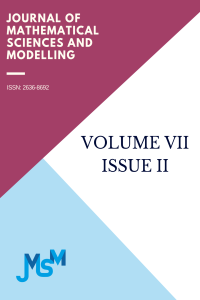Abstract
Project Number
FYL-2023-5925
References
- [1] C. Nypaver, C. Dehlinger, C. Carter, Influenza and influenza vaccine: a review, Journal of Midwifery & Women’s Health, 66(1) (2021), 45-53.
- [2] A. D. Iuliano, et al., Estimates of global seasonal influenza-associated respiratory mortality: A modelling study, The Lancet, 391 (10127) (2018), 1285-1300.
- [3] Y. Wang, et al., Vaccination coverage with the pneumococcal and influenza vaccine among persons with chronic diseases in Shanghai, China, 2017, BMC Public Health, 20 (2020), 1-9.
- [4] R. Allard, et al, Diabetes and the severity of pandemic influenza A (H1N1) infection, Diabetes care, 33(7) (2010), 1491-1493.
- [5] https://www.who.int/news-room/spotlight/history-of-vaccination/history-of-influenza-vaccination?topicsurvey=ht7j2q)&gclid=Cj0KCQiAwbitBhDIARIsABfFYIJGDMPmzAm9bfYs7KULeumVIdTyBz8jYArZ40HX6oRQbYoQzhpXm1YaAqUqEALw wcB
- [6] https://grip.saglik.gov.tr/tr/tedavi.html
- [7] R. Kumar, S. Kumar, A new fractional modelling on susceptible-infected-recovered equations with constant vaccination rate, Nonlinear Engineering, 3(1) (2014), 11-19.
- [8] Z. M. Odibat, N. T. Shawagfeh, Generalized Taylor’s formula, Appl. Math. Comput., 186(1) (2007), 286-293.
- [9] W. Lin, Global existence theory and chaos control of fractional differential equations, J. Math. Anal. Appl., 332(1) (2007), 709-726.
- [10] P. Van den Driessche, J. Watmough, Reproduction numbers and sub-threshold endemic equilibria for compartmental models of disease transmission, Math. Biosci., 180(1-2) (2002), 29-48.
- [11] D. Matignon, Stability results for fractional differential equations with applications to control processing, Computational Engineering in Systems and Application, In: Multiconference, IMACS, IEEE-SMC, Lille, France, 2 (1996), 963-968.
- [12] E. Ahmed, A.M.A. El-Sayed, H.A.A. El-Saka, On some Routh–Hurwitz conditions for fractional order differential equations and their applications in Lorenz, Rossler Chua and Chen systems, Phys. Lett. A, 358(1) (2006), 1-4.
- [13] P. Tomasek, On Euler methods for Caputo fractional differential equations, Arch. Math., 59 (2023), 287-294.
Abstract
We produced an SIR model of influenza which is a global infectious disease, by using Caputo fractional derivative. In this model, we separated S and I into different groups. Separation is made according to the group of people in S who get vaccinated and are protected from influenza, also people in S who get vaccinated but are not protected besides people in S who do not get vaccinated. Furthermore, infected people are separated as treated and untreated people in I. We did stability analysis of the model and produced the basic reproduction number. We emphasized the importance of influenza vaccine and treatment for infected people by varying the values of the parameters and was shown with graphics.
Keywords
Basic Reproduction Number Fractional SIR Model Influenza Rates Of Treatment And Vaccination Stability Analysis
Project Number
FYL-2023-5925
References
- [1] C. Nypaver, C. Dehlinger, C. Carter, Influenza and influenza vaccine: a review, Journal of Midwifery & Women’s Health, 66(1) (2021), 45-53.
- [2] A. D. Iuliano, et al., Estimates of global seasonal influenza-associated respiratory mortality: A modelling study, The Lancet, 391 (10127) (2018), 1285-1300.
- [3] Y. Wang, et al., Vaccination coverage with the pneumococcal and influenza vaccine among persons with chronic diseases in Shanghai, China, 2017, BMC Public Health, 20 (2020), 1-9.
- [4] R. Allard, et al, Diabetes and the severity of pandemic influenza A (H1N1) infection, Diabetes care, 33(7) (2010), 1491-1493.
- [5] https://www.who.int/news-room/spotlight/history-of-vaccination/history-of-influenza-vaccination?topicsurvey=ht7j2q)&gclid=Cj0KCQiAwbitBhDIARIsABfFYIJGDMPmzAm9bfYs7KULeumVIdTyBz8jYArZ40HX6oRQbYoQzhpXm1YaAqUqEALw wcB
- [6] https://grip.saglik.gov.tr/tr/tedavi.html
- [7] R. Kumar, S. Kumar, A new fractional modelling on susceptible-infected-recovered equations with constant vaccination rate, Nonlinear Engineering, 3(1) (2014), 11-19.
- [8] Z. M. Odibat, N. T. Shawagfeh, Generalized Taylor’s formula, Appl. Math. Comput., 186(1) (2007), 286-293.
- [9] W. Lin, Global existence theory and chaos control of fractional differential equations, J. Math. Anal. Appl., 332(1) (2007), 709-726.
- [10] P. Van den Driessche, J. Watmough, Reproduction numbers and sub-threshold endemic equilibria for compartmental models of disease transmission, Math. Biosci., 180(1-2) (2002), 29-48.
- [11] D. Matignon, Stability results for fractional differential equations with applications to control processing, Computational Engineering in Systems and Application, In: Multiconference, IMACS, IEEE-SMC, Lille, France, 2 (1996), 963-968.
- [12] E. Ahmed, A.M.A. El-Sayed, H.A.A. El-Saka, On some Routh–Hurwitz conditions for fractional order differential equations and their applications in Lorenz, Rossler Chua and Chen systems, Phys. Lett. A, 358(1) (2006), 1-4.
- [13] P. Tomasek, On Euler methods for Caputo fractional differential equations, Arch. Math., 59 (2023), 287-294.
Details
| Primary Language | English |
|---|---|
| Subjects | Applied Mathematics (Other) |
| Journal Section | Articles |
| Authors | |
| Project Number | FYL-2023-5925 |
| Early Pub Date | June 11, 2024 |
| Publication Date | August 31, 2024 |
| Submission Date | April 22, 2024 |
| Acceptance Date | May 29, 2024 |
| Published in Issue | Year 2024 Volume: 7 Issue: 2 |
Cite
Journal of Mathematical Sciences and Modelling
 The published articles in JMSM are licensed under a Creative Commons Attribution-NonCommercial 4.0 International License.
The published articles in JMSM are licensed under a Creative Commons Attribution-NonCommercial 4.0 International License.

